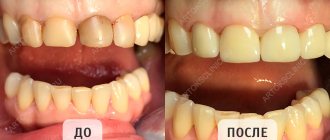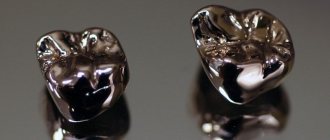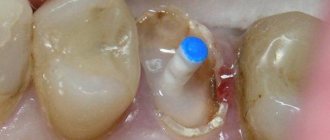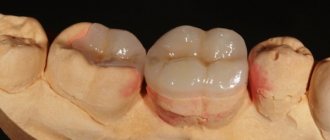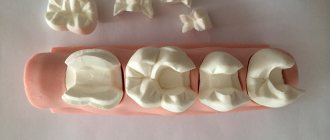How does an inlay differ from a filling?
The filling is made of a plastic material that hardens and takes the desired shape. It is made and installed right in the dentist's office in one appointment. However, a filling will not help when the tooth is severely damaged. In this case, you will need a ceramic inlay. It is made in the laboratory using an individual impression. It not only closes the resulting cavity, but also exactly repeats the shape of the destroyed area of the crown.
Advantages over fillings:
- Higher efficiency
. It is possible to restore a severely damaged tooth. A filling is suitable only if the cavity occupies less than a quarter of the crown, and an inlay can restore from 25 to 60%; - Naturalness
. The inlay imitates the anatomical shape of the chewing surface. It is almost invisible, while the filling can be seen; - Higher strength
. Microprostheses do not develop cracks. A filling of this size would quickly crumble, so it is not suitable for restoring extensive damage; - Durability
. The tab will last 5–7 years. At the same time, it will remain unchanged and will not lose its original characteristics; - Ensuring the prevention of secondary caries
. Sometimes the filling can become infected again. The insert fits very tightly and does not shrink over time, so this risk is eliminated; - Color fastness
. The fillings have a porous structure, so they are easily stained by tea, coffee, and tobacco. Ceramics are not subject to color changes.
Flaws:
- They cost more;
- They take longer to produce. The filling can be placed in one visit to the dentist. And to install the tab, you will need 2 visits with a break for the manufacture of a microprosthesis in the laboratory.
Stages of installation of a microprosthesis
During the first visit, the specialist conducts a careful visual inspection of the damaged element and examines the X-ray image. Next, he selects the appropriate treatment vector. To begin with, be sure to treat the carious cavity, remove necrotic areas, disinfect and prepare hard tissues. If necessary, depulpation is performed (the nerve is removed), after which the doctor cleans and seals the canals. After the cavity has been fully prepared, the doctor takes impressions and sends them to the laboratory. Impressions are also taken from the antagonist tooth. This allows you to determine how the tab should be positioned so as not to interfere with the correct closure of the jaws. Until it is ready, the patient is given a temporary filling.
At the second visit, the temporary filling is removed and the orthopedic product is tried on. If there are no complaints and the structure does not need to be sent for correction, it is fixed with durable dental cement. The excess is removed, the surface of the crown is ground and polished.
Indications
The main use case is the treatment of caries. A ceramic inlay for a tooth is needed if its crown is destroyed by 25–60%. If the cavity occupies less than a quarter of the surface, then you can get by with a filling, but if more than 60%, then a crown is needed. Other indications for installation:
- Destruction of non-carious origin;
- The need to install a bridge prosthesis (microprostheses are placed on abutment teeth to increase their strength);
- Increased abrasion of enamel.
Indications and contraindications for installation
Indications for tooth restoration using a ceramic microprosthesis:
- The need to restore chewing teeth that have a significant cavity formed as a result of caries or trauma, when it is impossible to eliminate the defect with filling. The technique is perfect even in cases where it is necessary to restore up to 50% of damaged tooth tissue.
- We are talking about replacing old large fillings. The need for tissue preparation, which involves the refilling procedure, will further enlarge the existing cavity and thin the walls of the tooth. Under such conditions, installing a new seal will not ensure reliability.
- There is a pathological abrasion of tooth tissues and, as a consequence, their destruction. Ceramics, which have increased strength, can completely prevent the loss of hard tissues due to their abrasion.
- Cases where the destruction of the coronal part of the tooth is great, it is possible to avoid depulping and covering the tooth with a crown.
You will have to refuse to use a ceramic inlay in the following cases:
- More than half of the destroyed tooth tissue needs to be restored. In this case, the only possible solution to save the tooth and avoid its removal is filling and subsequent installation of a crown.
- We are talking about baby teeth or numbers of eights. With such extensive damage to the wisdom tooth, surgical tactics are taken as the basis; removal will be required.
The main differences between a filling and a ceramic inlay
A ceramic inlay differs from a filling in a number of ways:
- The material from which ceramic inlays are made is similar in physical and chemical properties to natural tooth tissue, due to which microprostheses are significantly superior to any type of filling in terms of strength and resistance to abrasion.
- Regarding aesthetics, the ceramic inlay looks completely identical to the tooth tissues, matching them in color and transparency. At the same time, the filling may have a different shade.
- The inlay is used to restore chewing teeth with significant tissue defects. The filling is used for small, no more than 30%, affected areas, which is associated with insufficient hardness of the material. If you try to install a larger filling, it will not be possible to ensure a sufficient quality of its fit, which will lead to the risk of reoccurrence of caries. At the same time, if all preparatory measures were carried out correctly, a ceramic onlay will reliably avoid such complications.
- In terms of service life, ceramic inlays have clear advantages. If a filling guarantees preservation of the result for about 5 years, then with the help of a microprosthesis you can expect that the tooth will last over 10 years.
- If a filling is made directly in the patient’s mouth by a dental therapist, then ceramic microprostheses are created in the laboratory, and the entire process is controlled by an orthopedic dentist. The course of treatment takes longer, but thanks to the technological features of the technique, the specialist has the opportunity to install a microprosthesis more tightly than a filling.
- The method of restoring a tooth using a ceramic inlay is more expensive. However, this conclusion is not absolute, since in the long term the patient receives a more reliable and durable restoration result.
Types of tabs
Today, the most popular classification of ceramic inlays, developed by the American Dental Association ADA, is considered. According to it, the following types of tabs are distinguished:
Inlay – a microprosthesis is fixed inside the tooth. In this case, restoration of the tubercles is not expected; the tab is, as it were, sandwiched between them. Such features ensure its high functional performance and viability. However, these clinical prerequisites make it possible to use a filling quite successfully, so specialists take an extremely balanced approach to choosing an inlay.
Onlay - this option of an inlay is used if one or more cusps of the tooth are destroyed and need restoration. By using an inlay, some of the cusps on the tooth remain their own, and some are replaced with a ceramic microprosthesis. However, when carrying out a chewing load, an overturning moment may occur, which negatively affects the fixation of the structure. Only a specialist’s impeccable knowledge of the anatomy of the dentofacial system, thorough diagnostics and impeccable precision in the execution of work can ensure the required quality of restoration carried out using this method.
Overlay is an option in which the inlay covers all the cusps of the tooth, which ensures maximum fastening strength. In such a clinical case, the doctor will be faced with a dilemma whether to use an inlay or perform additional grinding of the tooth and install a crown.
Pinlay is a special version of the inlay, which involves the presence of a pin in its design, with the help of which better fixation of the entire structure is ensured. This option is suitable for any type of inlay, on any tooth.
How a ceramic inlay is created for teeth
The production of a ceramic inlay goes through several stages:
- If necessary, the doctor removes the remains of old fillings, damaged tooth tissue, smoothes the walls of the cavity, which will ensure high-quality impressions and, in the future, a tight fit of the inlay. Then the resulting cavity is treated with medication.
- Taking an impression. Since the inlay is a microprosthesis, it is to the dental laboratory that the finished impressions are sent.
- The laboratory stage assumes that, based on the impressions obtained, the dental technician casts a plaster model, and then restores the lost part of the tooth using ceramic mass. The process consists of applying the material in thin layers and sequential firing in a special oven, where, in addition to high temperature, about 700 degrees, vacuum conditions are created. The color of the ceramic microprosthesis is selected individually, taking into account the basic tone of the patient’s enamel. The created product is carefully polished and handed over to the doctor. The use of ultra-precise technology and computer modeling techniques allows us to take this technology to a new level, significantly increasing the quality of the resulting product and the compliance of the microprosthesis with the cavity being restored. When creating an e.max Press ceramic inlay, standard impressions are not required. The doctor will receive the necessary information by scanning the tooth, nearby and opposite areas using a compact 3D camera. The software will be used at each subsequent stage, when creating a virtual model of a tooth, an inlay, as well as when turning a real model on a special milling module connected to a computer. By making an inlay using this method, using computer technology, the impeccability of the result will be guaranteed.
- At the patient’s subsequent visit, the doctor tries on the finished microprosthesis. The specialist evaluates the fit of the tab and the contact with neighboring teeth. If no modification is required, attach it to the tooth using adhesive material.
Considering this entire multi-stage technological process, it becomes clear that such a complex design cannot be used inexpensively. In addition to direct manufacturing and payment for the services of a dental technician, the cost of diagnostics, tooth processing, taking impressions, selection of shape and color, and the purchase of expensive materials and ceramic mass are also involved in determining the price. Will increase the final cost and use of digital technologies.
Advantages and disadvantages of products
Ceramic inlays are significantly superior in quality to composite fillings. And this is due, on the one hand, to the physical and chemical properties of the material, and on the other hand, to the peculiarities of creating microprostheses. Based on these features, the advantages of ceramic inlays are:
- High manufacturing precision, which minimizes the risk of developing recurrent caries, guarantees the reliability of restorations and extends the life of the tooth. In fact, the inlay and the tooth become one. As a result of life activity, your own enamel is more likely to be destroyed than a ceramic inlay.
- Excellent aesthetic characteristics. Inlays are exactly identical to natural tooth tissue in appearance.
- High wear resistance. Ceramics are not subject to staining with food dyes and exposure to aggressive substances in the oral cavity.
- Lack of special care. It is enough not to ignore daily standard hygiene procedures and visit the dentist in a timely manner for a preventive examination and professional teeth cleaning.
Where is the best place to install ceramic inlays?
Considering the high costs of installing a ceramic inlay, the question of where it is best to carry it out is not idle. To fully obtain an aesthetic, reliable and long-term result, you need to use the services of the most qualified specialists who have extensive practical experience in installing such orthopedic structures. The specialists of the Dental Studio clinic in Moscow are the best solution.
Our dentists constantly, every day, prove their professionalism with the high-quality results of their work. Success is fully guaranteed when installing ceramic inlays. Using this technique, you can extend the life of a decayed tooth without installing a crown.
Contraindications
This type of microprosthesis cannot be installed in the following cases:
- bruxism (grinding teeth in sleep);
- steep slopes of hillocks;
- rapidly progressing caries;
- deep cavity extending into dentin;
- inability to ensure complete dryness of the field.
A relative contraindication is poor oral hygiene. In what cases is it not advisable to use:
- A cavity less than 1.5 mm deep (you can get by with a filling);
- The damage has affected the cervical area of the tooth (the inlay will no longer help);
- The tooth is more than 60% destroyed (a crown is required);
- Milk tooth. It makes no sense to restore it using an inlay, since the life of the tooth is less than the durability of the microprosthesis. In addition, a vlkadka costs much more than a filling. Spending so much money to restore a tooth that will soon fall out is not advisable.
What are they?
A ceramic inlay is a fragment that replaces the lost part of the teeth. They are designed to restore crowns that have been destroyed by more than 30%, and in cases where the use of conventional filling materials is not possible.
Products differ from each other in material of manufacture, production method and performance indicators. The inlay completely follows the shape and size of the teeth, protecting them from further destruction. The structure can be placed on both the external and internal sides of the teeth.
Types of tabs
Depending on the material of manufacture, they come in the following types:
- metal-ceramic
- the most budget-friendly; - ceramic
– the most aesthetic; - made of zirconium dioxide
- the most durable.
These microprostheses are also classified depending on their position in the tooth. According to this criterion, the following varieties are distinguished:
- Inlay
– the hole in the tooth is box-shaped, the inlay is installed inside it; - Onlay
– the overlay has an external side; - Overlay
– only one wall is preserved, the overlay replaces almost the entire crown; - Pinlay
– the inlay has additional cavities or pin inclusions for better fixation.
The type of inlay based on its position in the tooth is selected by the dentist after an initial consultation.
Features of the ips e.max system.
Modern people think about and care about their health. A beautiful, natural smile is important to him, and in order to meet his ideal, he undergoes timely examinations with a dentist, and if problems arise, he begins treatment. Damage to the tooth structure can occur due to mechanical injuries, advanced pathologies, age-related changes and other reasons. According to Ivoclar Vivadent, IPS e.max metal-free ceramics is all we need. It was they who created this system more than 15 years ago and revolutionized aesthetic dentistry. As a result of research, it has been proven that this development has a lot of advantages, while it is easy to use and consists of several components. Depending on the specific clinical situation, the doctor selects the appropriate all-ceramic material.
The process of manufacturing and installing inlays on a tooth
Dental prosthetics is performed in several stages:
- Initial consultation
. The doctor assesses the extent of destruction and draws up a recovery plan; - Hygienic teeth cleaning
if necessary; - Selection of the required shade
to match the enamel color; - Removal of tissues affected by caries
, if the destruction was caused by this disease; - Taking an individual impression
, according to which a microprosthesis will be made; - Closing the cavity with temporary material
for the waiting period; - Making an inlay
based on an individual impression in a dental laboratory; - Installation
of the inlay and its fixation using special dental cement.
Thus, a tooth can be restored in 2 visits to the clinic. The first visit is a consultation, treatment of caries and taking an impression, the second is the actual installation.
Care and possible complications
For the entire period of production of the ceramic inlay, the tooth cavity is filled with a temporary filling, so the patient must be quite careful, otherwise there is a risk of the filling falling out and damaging the tooth, which without a prosthesis becomes very vulnerable. After the inlay has been installed, the doctor usually advises you to avoid eating solid foods for at least a couple of days, and also not to clench your jaw too hard. No special care for the inlays is required - it is enough to carry out daily high-quality hygiene and regularly make preventive visits to the doctor. Patients are often concerned about possible complications associated with the installation of a ceramic inlay. If the treatment was carried out by a qualified specialist and high-quality materials and good equipment were used, there should be no cause for concern. Most often, complications arise due to errors at the planning and manufacturing stage of the inlay.
- Untreated dental diseases that develop already under the tab.
- Ignoring contraindications to the installation of a microprosthesis.
- Wrong color selection.
- Errors in calculations and production of the prosthesis. Because of this, microgaps most often occur.
Pros of ceramic inlays
A ceramic tooth inlay has many advantages:
- High strength
. An inlay, unlike a filling, significantly strengthens the tooth. Therefore, it is the preferred option if the tooth in which it is installed will be used as a support for a bridge; - Good aesthetic properties
. Ceramics are translucent, so they successfully imitate the natural color of the tooth. It also exactly follows the normal shape of his crown; - The ability to fully restore the chewing surface
. The inlay completely follows the anatomical shape of the tooth. This provides convenience when eating; - Hygiene
. Glaze is applied to the tab as a finishing layer. It creates a glossy surface on which plaque does not accumulate; - Resistance to external factors
. Ceramics does not darken over time, does not change color due to smoking or drinking coloring drinks; - Durability
. A ceramic inlay will last longer than a filling – 5–7 years. There are also more durable inlays, for example, made of zirconium dioxide, but ceramic ones are more aesthetically pleasing compared to them; - No risk of secondary caries
. Inlays, unlike fillings, do not shrink and adhere tightly to the tissue. This eliminates the possibility of cracks and the development of secondary carious lesions; - Easy replacement
. When installing a new inlay after its service life has expired, there is no need to grind the tooth again. Caries does not develop under a microprosthesis of this type, so there is no need to remove the affected tissue. - Bioinertness
. Ceramics does not absorb or accumulate any odors. There is no plaque deposited on it; - Hypoallergenic
. Microprostheses made of pure ceramics do not cause any immune reactions; - No need for special care
. Regular hygiene rules are sufficient.
Comparison of ceramics with other materials
Ceramics is far from the only material from which inlays are made.
They can be made from various metal alloys (including precious ones) or from a combination of metal and ceramics, but only ceramic or zirconium inlays are considered the best in terms of aesthetics and reliability. For example, a metal-ceramic tooth inlay is inferior to solid ceramics in reliability, and most metal alloys are not bioinert. The exception is gold tabs. Gold does not cause allergies, and thanks to the plasticity of the material, it is possible to “fit” the insert well and eliminate the occurrence of micro-gaps. There are nuances regarding the ceramics itself. Just 30-40 years ago, the dental industry did not have the production technology to produce reliable all-ceramic inlays. Despite the fact that ceramics is a safe and aesthetic material, it is quite fragile and poorly suited for chewing teeth, and it is the lateral teeth that are most often restored with the help of inlays. That is why special high-strength ceramics made by injection molding under high pressure are used to produce inlays. Another method is the CAD/CAM technique. This is a fully automated process. The doctor uses equipment and software that allows the patient’s individual data to be loaded into a special milling module, which cuts products from zirconium dioxide blocks. The most well-known technologies at the moment are CEREC and e.max: such inlays are considered the most reliable and aesthetic and are used in the best clinics around the world.
Flaws
Ceramic dental inserts have virtually no disadvantages. But there are still shortcomings. This is primarily a high cost compared to the price of installing a filling, which is explained by the high cost of the materials used and the complexity of manufacturing.
In addition, treatment with onlays is longer than with a conventional filling and may require several visits to the dentist.
Another disadvantage is the presence of contraindications for the use of overlays.
What stages are included in microprosthetics?
- preparation: the dentist removes the remains of the old filling or prepares enamel and dentin affected by caries, if necessary, treats and fills the root canals,
- taking impressions: impressions are taken not only from the causative tooth, but also from those with which it contacts or intersects. A more modern method is a 3D scan of the oral cavity, the parameters of which are entered into a computer program. Next, the patient is given a temporary filling for several days or weeks to protect the tooth from infection and damage.
- creation of a model: a physical model is created in the laboratory, which is tried on the patient (here you can make additions or adjustments to make an ideal microprosthesis),
- manufacturing: during the manufacturing stage, the final version of the ceramic inlay is created. To improve aesthetics, it can be painted, lined with ceramics, polished - so that the restoration takes on a natural shine and food coloring is not absorbed into the material,
- fixation of the finished ceramic inlay: for this it is recommended to use three-stage fixation materials, for example, the Syntac universal adhesive system from Ivoclar Vivadent.
The entire process of preparation, manufacturing, and adjustments may take 1-3 weeks (depending on the workload of the laboratory). Fixation occurs within 20-30 minutes, and here it is important to carefully remove the temporary filling, as well as treat the cavity with an antiseptic.
“Not long ago I got myself a ceramic filling, or rather an inlay. That's what the prosthetist called her. Looks very real, like your own tooth. But the downside is that it takes a long time to do it. And all this time you need to chew carefully. Otherwise, you can chip a tooth with a temporary filling. Then you’ll have to make new impressions and a new prosthesis, and pay again.” Artem I., review from otzovik.com
Why is precision inlay design necessary?
For small interventions, manual precision work with fillings and additional correction is sufficient.
In large reconstructions, it is often necessary to restore the cusps on the teeth that ensure proper contact. We build an occlusal compass to model the oral cavity so that movements are limited, that is, to ensure the correct mechanics of teeth closure. It is basically impossible to do the same thing in the mouth using filling material. Yes, you can achieve aesthetics with fillings, but correct mechanics with large interventions with several teeth is almost never possible. When a filling is required not on top, but on the side surface of the tooth, it is necessary to restore the contact point (so that the thread passes with a click): this is necessary so that food does not pass down and injure the periodontal papilla. It is very difficult to restore the contact point with the correct anatomy. In addition to the contact point itself, there is an approximal ridge with a triangular fossa. He rolls the food bolus not between the teeth, but towards the chewing surface of the tooth:
On a filling it is often not easy to do this manually. And another difficulty is when we have a defect on the side, and it is critically important that the restoration or filling is level with the level of the tooth: if it is wider, then food will get there and there will be caries below. If already, there will be a step that will create mechanical difficulties.
Kinds
There are 3 main types of inlays, which differ in material of manufacture, service life and cost. The modern type of material from which products are made is metal ceramics. Their cost is not much different from ceramic structures, but in quality they are significantly inferior to them. Cermet inlays may fall out when exposed to too high or low temperatures. This is due to the ability of the metal to expand under the influence of temperature factors. For this reason, dentists do not advise patients to resort to modern methods of dental reconstruction.
Inlays can also be made from pressed ceramics. Porcelain is used to produce structures of the required shape and size under the influence of high temperatures. As a result of laboratory work, inlays are durable and resistant to external influences. In terms of strength, they are not inferior to zirconium samples. Ceramic structures are recommended for use in cases of significant destruction of dental elements.
Zirconium is another material used to make inlays. The resulting products are in no way inferior to porcelain in terms of technical characteristics. They are turned on modern machines using pre-prepared plaster models. All stages of work are controlled automatically by high-precision devices.
Depending on their purpose, structures are divided into restorative and stump. The former allow you to restore the integrity of the tooth crown with a healthy root system.
Stump inlays: what do you need to know about them?
At the very beginning of our article, we said that stump inlays should not be confused with restorative microprostheses - they are used to restore pulpless and severely damaged teeth, in which they will serve as the basis for installing a crown or dental bridge.
Stump inlays are structures consisting of two parts: a pin installed in the root canal and a support on which the crown will be fixed. Stump inlays can be monolithic or collapsible, and most often this type of structure is used when the tooth has less than 50% of healthy tissue left.
Many people are interested in the question: why is it best to use core inlays rather than fillings on a pin to restore severely damaged teeth? The fact is that the pin may not withstand the load and begin to wobble in the canal, and this will either lead to the filling breaking or falling out, or, worst of all, to damage to the tooth root, in which the tooth is most often removed. Stump inlays allow you to avoid such risks because they distribute the load more correctly and themselves have much greater strength compared to pins.
Stump inlays are also made in the laboratory and the construction material is selected to match the type of dental crown that is planned to be placed in the future. Metal core inlays are used for metal-ceramic crowns, and zirconium inlays are used for ceramic crowns. If you make a metal inlay for a ceramic crown, it can shine through the thin and transparent material of the crown, which will have a bad effect on the aesthetics of the restoration.
Tooth restoration using a core inlay will also be divided into several stages: diagnostics, preparation, during which a cavity is formed in the tooth for the inlay, manufacturing of the inlay, and its installation. After installing the core tab, the crown is fixed on it and this completes the process of tooth restoration.
If the tooth is destroyed, but there is a living nerve in it, before installing the stump tab, depulpation is carried out, as well as treatment and filling of the root canals. It is important that these procedures are carried out without errors, since poor canal processing leads to various kinds of complications, the elimination of which requires complex and lengthy treatment.
Product installation technology
Below is a detailed process for installing ceramic products.
| Steps | Description of actions |
| Step one | If there are old fillings, they are first removed using a special machine. Cooling with water helps prevent tooth overheating. Grinding of the tooth being restored occurs using magnifying instruments, most often binocular glasses. This is due to the need to preserve as much healthy dental tissue as possible. |
| Step two | After grinding, the tooth surface is treated with a special tool - a caries detector. It is washed off the teeth when rinsing with water. The caries detector allows you to check whether all damaged tooth tissue has been removed from the patient. |
| Step three | After this, precise grinding is carried out, and at the end all edges of the processed tooth are smoothed with an Arkansas stone. All these actions are necessary to improve the fit of the ceramic inlay. |
| Step four | Before taking an impression, a special protective agent is applied to the tooth, which is also washed off when rinsing. After this, an impression is taken for the dental technician. The test is also carried out using binocular glasses. |
| Step five | Now the manufactured tab is glued. For this purpose, different types of glue are used: some harden under the influence of ultraviolet light, others need to be mixed before application. In any case, the doctor must strictly follow the manufacturer's instructions. This also applies to all substances for treating teeth, including special polishing pastes, etching gel, glycerin gel for glue hardening, and so on. |
There are special rules of oral hygiene that the patient must follow after installation of the structure. This will reduce the load placed on the restored tooth, as a result of which the microprosthesis will last much longer.
Price
Ceramic inlays are not cheap, because expensive materials are used to make them, and the manufacturing process is quite labor-intensive. But a large number of advantages of such products, including a long service life (more than 10 years), are quite commensurate with their cost.
The cost of the Empress ceramic inlay is approximately 16 thousand rubles, and the IPS e. max Press" will cost 18 thousand rubles.
We offer an overview of turnkey prices in Moscow clinics for tabs:
| Clinic | Ceramic inlay | CEREC technology |
| Capital | 10000 | 12000 |
| Lucky Smile | 10200 | 13800 |
| Ideal-Dent | 8400 | 11400 |
| Best Clinic | 10800 | 15600 |
| Dento El | 10200 | 15000 |
Types and brands of ceramic materials
Types of ceramic inlays differ in materials. Since ceramics include not only porcelain (in the classical view, this is ordinary feldspar), but also ceramic raw materials with various additives - they are also called “metal-free ceramics”. Let's take a closer look at the materials used:
- feldspathic ceramics: usually these are liquid or plastic materials for layer-by-layer application and baking in a special oven, for cladding - i.e. to enhance the aesthetics of other materials. For example, the Shofu brand Vintage Halo, VITA VM 13 from VITA Zahnfabrik, IPS e.max Ceram. They have good aesthetics, but lower strength (40-60 MPa) compared to more modern materials. It is worth adding that feldspar in different concentrations can be added to different types of ceramics,
- nanoceramics: liquid raw materials containing submicron glass - for example, ceram.x Sphere TEC material from Dentsply Sirona. Can be used both for filling and for making microprostheses in the laboratory,
- leucite glass ceramics: contains leucite crystals, which give the ceramics strength (160 MPa) and translucency with a “chameleon” effect. Typically, manufacturers produce glass ceramics in 7-12 color and transparency options, which makes it universal for both young and elderly patients. Popular brands are IPS Empress Esthetic ET, IPS Empress CAD HT from Ivoclar Vivadent and VITABLOCS Mark II from VITA Zahnfabrik. The material is processed according to the principles of injection molding or milling using a CAD/CAM system, produced in the form of blocks or small cylinders,
- glass ceramics based on lithium disilicate: such glass ceramics have increased strength (470 MPa) and allow you to create aesthetic restorations regardless of the original shade of the tooth. The highest quality brand is IPS e.max Press HT from Ivoclar Vivadent. In general, "E.Max" is considered an advanced material for pressing technology,
- reinforced glass ceramics (based on lithium disilicate and zirconium dioxide): strengthened material (more than 500 MPa) containing 10% zirconium dioxide. For example, Celtra Press and Celtra Duo from Dentsply Sirona, which are primarily suitable for inlay and onlay restorations,
- hybrid ceramics: ceramic-polymer properties give the material strength and elasticity - the ability to absorb chewing loads without destroying the structure (VITA Enamic T, HT, ST brand),
- zirconium dioxide: the most durable material (up to 1400 MPa), which belongs to metal-free ceramics. It is processed only by milling (we will discuss the methods below). Many manufacturers produce zirconium dioxide only in white, but the most progressive ones have learned to color it in natural shades. Popular brands – IPS e.max CAD, Prettau Zirkon from Zirkonzahn.



